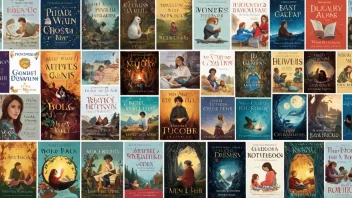Young Adult (YA) literature has become a powerful medium for addressing complex themes that resonate deeply with its audience. Among these themes, loss and grief stand out as particularly poignant, offering a lens through which young readers can explore their emotions and understand the intricacies of life. This article delves into the representation of loss and grief in YA literature, examining how authors tackle these difficult subjects and the impact they have on readers.
The Significance of Loss and Grief in Young Adult Literature
In the formative years of adolescence, individuals often encounter various forms of loss, whether it's the death of a loved one, the end of a friendship, or the loss of a childhood home. YA literature reflects these experiences, providing validation and a sense of community for young readers grappling with their own feelings of grief. By addressing these themes, authors create a space for empathy and understanding, allowing readers to explore the ways in which loss shapes identity and personal growth.
Key Themes and Motifs in YA Literature on Loss and Grief
YA literature often employs specific themes and motifs to convey the complexities of loss and grief. Some of the most common include:
- Death and Mourning: Many YA novels explore the aftermath of a loved one’s death, illustrating the various stages of grief through the eyes of the protagonist. For instance, in John Green's The Fault in Our Stars, the characters grapple with terminal illness and the reality of mortality, inviting readers to reflect on their own perceptions of death.
- Friendship and Support: The importance of friendships during times of grief is another significant theme. Books like Thirteen Reasons Why by Jay Asher emphasize how relationships can both aid and complicate the grieving process, highlighting the need for connection and understanding.
- Identity and Self-Discovery: The journey of self-discovery often coincides with experiences of loss. Characters in novels such as We Were Liars by E. Lockhart often find that their understanding of themselves is irrevocably altered by their experiences with grief.
- Healing and Moving Forward: Many YA novels focus on the healing process, illustrating how characters learn to cope with their grief and find new paths forward. This theme is evident in books like Before I Die by Jenny Downham, where the protagonist's journey reflects the struggle between holding on and letting go.
Notable YA Novels Addressing Loss and Grief
Several contemporary YA novels have been particularly effective in exploring the themes of loss and grief. Here are a few notable examples:
The Fault in Our Stars by John Green
This bestselling novel tells the story of Hazel Grace Lancaster, a teenager battling cancer who falls in love with Augustus Waters, a fellow cancer patient. Through their relationship, Green explores the realities of illness, love, and the inevitability of loss. The emotional depth of the narrative resonates with readers, inviting them to confront their own fears about mortality.
Thirteen Reasons Why by Jay Asher
In this groundbreaking novel, the protagonist Clay Jensen receives a series of tapes recorded by his classmate Hannah Baker before her suicide. The book delves into the impact of bullying, isolation, and the consequences of one's actions, demonstrating how grief can manifest in various forms. The intertwining narratives encourage readers to reflect on their own relationships and the importance of empathy.
All the Bright Places by Jennifer Niven
This novel follows the story of Finch and Violet, two teens grappling with mental health issues and the trauma of loss. Niven explores themes of depression, grief, and the transformative power of love, illustrating how connection can foster healing. The poignant portrayal of the characters’ struggles resonates deeply with readers, making it a significant contribution to YA literature.
Bridge to Terabithia by Katherine Paterson
A classic in children's and young adult literature, this novel tells the story of Jess Aarons and his friendship with Leslie Burke. The unexpected loss of Leslie profoundly affects Jess, forcing him to confront his grief and ultimately find solace in the memories they shared. Paterson's exploration of friendship and loss remains impactful and relevant across generations.
The Impact of Loss and Grief on Young Readers
The representation of loss and grief in YA literature can have a profound impact on young readers. These narratives provide an avenue for emotional exploration, allowing readers to process their own experiences of loss. The following points highlight the benefits of engaging with these themes:
- Validation of Emotions: Readers often find solace in knowing that their feelings are shared by others, fostering a sense of belonging and understanding.
- Encouragement to Discuss Grief: YA literature often opens the door for conversations about grief, encouraging young readers to share their experiences and seek support.
- Development of Empathy: Exposure to diverse perspectives on loss can cultivate empathy in readers, helping them understand and support others who are grieving.
- Empowerment through Healing: Stories of resilience and healing can inspire readers to navigate their own grief journeys with hope and courage.
Literary Techniques Used to Convey Loss and Grief
Authors employ various literary techniques to effectively convey the themes of loss and grief in YA literature. Some notable methods include:
Symbolism
Symbolism plays a crucial role in representing loss and grief. Objects, settings, or recurring motifs can embody a character's emotional state. For example, in The Book Thief by Markus Zusak, the act of stealing books symbolizes the protagonist's desire to find solace amidst the chaos of war and loss.
Imagery
Vivid imagery allows readers to experience the emotional weight of loss. Authors often use descriptive language to evoke feelings of sadness, nostalgia, and longing. This technique is prevalent in novels like Looking for Alaska by John Green, where the imagery reflects the characters' internal struggles with grief.
First-Person Perspective
Many YA novels utilize a first-person narrative to provide an intimate glimpse into the protagonist's thoughts and feelings. This perspective fosters a deep connection between the reader and the character, allowing for a more personal exploration of grief.
Non-linear Narratives
Non-linear storytelling can effectively convey the disorienting nature of grief. By presenting events out of chronological order, authors mimic the chaotic emotions that accompany loss. This technique is exemplified in novels like The Perks of Being a Wallflower by Stephen Chbosky, where the protagonist’s reflections on past experiences intersect with present moments of grief.
Conclusion
Loss and grief are integral themes in Young Adult literature, reflecting the realities of adolescence and the emotional complexities that accompany it. Through compelling narratives and relatable characters, authors create a safe space for young readers to explore their feelings, fostering empathy and self-discovery. As readers engage with these themes, they not only find validation in their experiences but also gain valuable insights into the human condition. YA literature's ability to tackle such profound subjects serves as a testament to its importance in young readers' lives, encouraging them to navigate the challenges of loss with resilience and hope.






